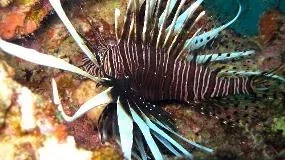 Elaine Blum 2009/Marine Photobank
Elaine Blum 2009/Marine Photobank
Lionfishes are venomous species of scorpionfishes which are native to IndoPacific and oceanic coral reef ecosystems and adjacent habitats. Because of their colorful and dramatic appearance, they are prized by aquarists around the world. Through accidental and purposeful release into warm Atlantic waters, they have become established as voracious alien species that pose a serious threat to coral reefs in Bermuda, the American tropics of Florida, the Gulf of Mexico, the Caribbean islands, Central America, and northern South America.
Impact on coral reef ecosystems
Lionfish experts are in agreement that invasive lionfish populations will continue to grow and cannot be eliminated using conventional methods. Lionfishes have become established along the southeastern coast of the United States, Bermuda, the Bahamas, and throughout the Caribbean. This places swimmers, snorkelers, divers, and fishermen at risk from their painful, venomous sting and leaves native reef fish populations and coral reef community stability at great risk from their interactions with this species. In a five-week experiment, scientists in the Bahamas established that lionfish can cause significant reductions (by 79%) in the recruitment of native fishes. One large lionfish was observed consuming 20 small fishes in a 30-minute period.
Lionfishes may, directly and indirectly, cause harm to coral reef ecosystems. As aggressive ambush predators with few predators of their own in their introduced range, lionfishes can quickly and alarmingly reduce local native reef fish (and some invertebrate) populations to the point where native piscivores cannot compete for these prey animals. This in-turn can cause a reduction in the growth and survival of the native predators. Stomach content analyses of lionfishes reveal a wide diversity in prey species and size classes. As stated by one participant in the discussion, lionfishes are eating nearly anything that will fit into their mouths.
Most lionfish prey on crustaceans and small-bodied forage fishes, including commercially and recreationally important snappers and groupers. Compared to total local reef biomass, lionfishes consume a considerable amount of prey biomass from the reef. In addition, experiments have shown that native reef fish may avoid feeding on juvenile lionfish, probably because of their venomous defense apparatus. There is great concern about the effect of the invaders on commercial and recreational fisheries. Since lionfishes feed on smaller fishes that are usually consumed by groupers and other native fishes, their existence could negatively affect the food chain of many commercial and other species. As one NOAA coral reef manager in North Carolina stated, “our biggest concern is how they impact the economic value of the shelf reef ecosystem. There may be reduced economic returns from commercial fisheries. The economic value of heavily impacted and devastated reefs may be reduced also as recreational divers and snorkelers stop visiting, and perhaps causing a major collapse of the local tourist industry. Recreational and commercial value of reef-related pelagic and benthic species is close to a half-billion dollars each year to the Carolinas.”
As lionfish colonize more territory in the Caribbean, they can have a devastating effect on coral reefs already stressed by climate change, pollution, disease, overfishing, sedimentation, and other stressors.
You can sign up for alerts for lionfish and you will receive an email every time a lionfish is found in a new island/region. Here is the link to sign up: http://nas.er.usgs.gov/AlertSystem/register.aspx.
Source: http://coris.noaa.gov/exchanges/lionfish/welcome.html